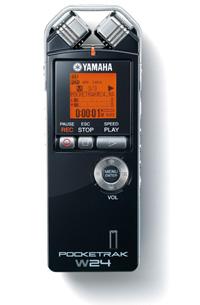 Digital audio recorders are becoming an almost essential part of every music education classroom. Teachers use them as assessment tools, to record individual student performances for later evaluation, or for recording and evaluating large ensemble rehearsals. Other classroom uses like producing podcasts or for individual student practice and reflection are also great reasons to consider investing in a digital audio recorder. The newest units are ultra-portable, easy to use, and in most cases provide excellent sound quality.
Digital audio recorders are becoming an almost essential part of every music education classroom. Teachers use them as assessment tools, to record individual student performances for later evaluation, or for recording and evaluating large ensemble rehearsals. Other classroom uses like producing podcasts or for individual student practice and reflection are also great reasons to consider investing in a digital audio recorder. The newest units are ultra-portable, easy to use, and in most cases provide excellent sound quality.
The contest for the free W24 is now closed. However you can still enter to win other great prizes in the 2010 MusicEdMagic Giveaway.
But how does one make the final decision of which digital audio recorder to buy? The answer lies in the fact that specific models seem to suit themselves better to specific classroom situations. Be aware that the suggestions shown below reflect the opinions of a single band director that has had the opportunity to test and do comparative reviews of over a dozen digital audio recorder models. Your personal preferences on brands or models may vary, but my experience has shown that the recommendations below work well for most people.
Size and Form Factor of Digital Audio Recorders
The first thing that most people want in a portable digital audio recorder is a very small, pocket sized, form factor. The problem is that the smaller the microphone the lower (in general) the quality of the recording will be. In most cases a larger diaphragm microphone will provide better quality recordings, so going smaller often means sacrificing certain frequency ranges. However, there are a few ultra-portable digital audio recorders that manage to pack a very responsive microphone into a very tiny device.
On the small end of things look for units like the Yamaha W24 or the Zoom H1. The Yamaha PockeTrak line was one of the first to go super small but as mentioned the microphone quality wasn’t that great in the early versions. The new PockeTrak W24 is actually very good and has the added benefit of having a wireless remote control. The Zoom H1 is actually a slimmed down version of the very popular H2 and H4 line, but they managed to keep the same larger diaphragm coincident pair microphones that give really good sound quality at a fairly low price.
Larger Units Often Provide Better Audio Quality and Features
For those that want to make sure they have better quality sound recordings and are willing to use a larger unit because of it consider the Edirol R-09HR, the Zoom H4n, or the Sony PCM-D50. The Sony PCM-D50 is a unit highly prized by some media producers such as National Public Radio, but it carries a steep price tag. For about $200 less the Zoom H4n provides the same level of flexibility with built in XLR jacks and phantom power plus the ability to record four channel audio. The Edirol R-09HR is a little bit less than the H4n, but is a lot less bulky and produced some of the best audio recordings of all in my testing.
Finding ways to use a digital audio recorder in a classroom is the easy part. For most, just picking the right one without having any buyers remorse a few weeks later is more difficult. Luckily, going with any of the suggestions listed above will insure that the purchase is a good one.
